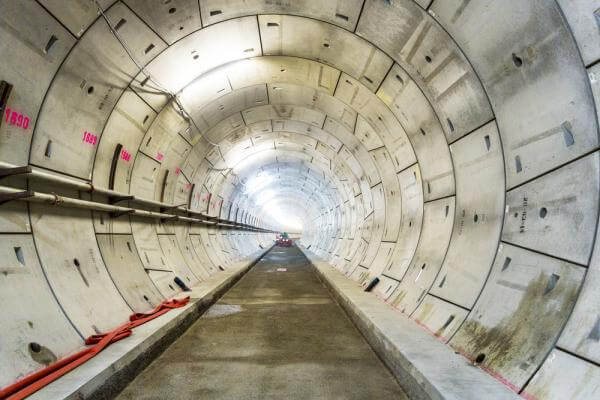How does a challenging tunnel project become a dynamic testbed for future technologies, safety solutions, mechanical innovation and sustainable thinking? This question has been solved by the J. Murphy & Sons Limited (Murphy) team during the ambitious £14.8bn London Crossrail project.
The 3km section running under the Thames from Plumstead to Woolwich, saw Murphy introduce new thinking and innovation. This includes installing pioneering ‘smart infrastructure’ fibre optic sensors, using sustainable ideas such as groundwater rather than potable water, the company designing and creating a new safety mechanism for its telehandler fleet, plus the company showed its surprising approach by using a cherry picker deep underground.
The project was a joint venture between Hochtief and Murphy (HMJV) and included the construction of a total of 42km of new twin bore tunnels, using two 1000-tonne boring machines. The £260m tunnel project was highly complex with a distinct set of challenges as well as presenting opportunities for Murphy to demonstrate its ability to adapt the best technology for the environment and work with the latest innovations.
Murphy fitted a fibre optics system embedded permanently within the concrete rings supporting the tunnel structure, allowing data collection and providing greater knowledge of how structures behave when in use. The sensors monitor any ground movement, the effect of loading caused by tidal changes and the ongoing integrity of the structure. The information is invaluable in the long-term for identifying areas that need maintenance and repair, offering remedial possibilities before problems arise.
Another industry first, driven by innovation and sustainability, was boring the tunnel with groundwater rather than potable water. This dewatering process saw the team undertaking a full risk assessment and working closely with the Environmental Agency. This sustainable measure alone saved 2 million litres of potable water per week, reducing carbon emissions by 23 tonnes, saving an estimated £100,000.
The in-house Never Harm cultural development programme encourages the teams at Murphy to develop new approaches for first-rate safety. A new device developed by Murphy, called the Safe T Zone, was installed on the telehandler fleet used on Crossrail. This bespoke solution minimises any unsafe movement of underslung goods, by limiting the operation of the telehandler, restricting its movement.
A further example of creative thinking, was the idea of transporting a cherry picker into the tunnel, so that operatives could reach the highest points easily and safely. The light Hybrid Niftylift Height Rider 21 was chosen for its combination of strength and ease of movement and proved ideal for attaching temporary lights the length of the tunnel and allowed operatives inject resin to seal the tunnel watertight. With an eye on safety, this model with its electric motor was chosen as it reduced the release of harmful emissions in enclosed environments, as well as minimising noise within the tunnel for better working conditions. With lower fuel consumption, running costs and noise emissions, the humble cherry picker ensured the project was completed safely and on time.
Paul Mohan, rail sector director at Murphy, commented: ‘Our work on Crossrail highlights our approach to projects, thinking creatively as to how far we can push boundaries to get the best results for our clients, integrating the latest technologies into projects and going the extra mile on sustainability.’
































